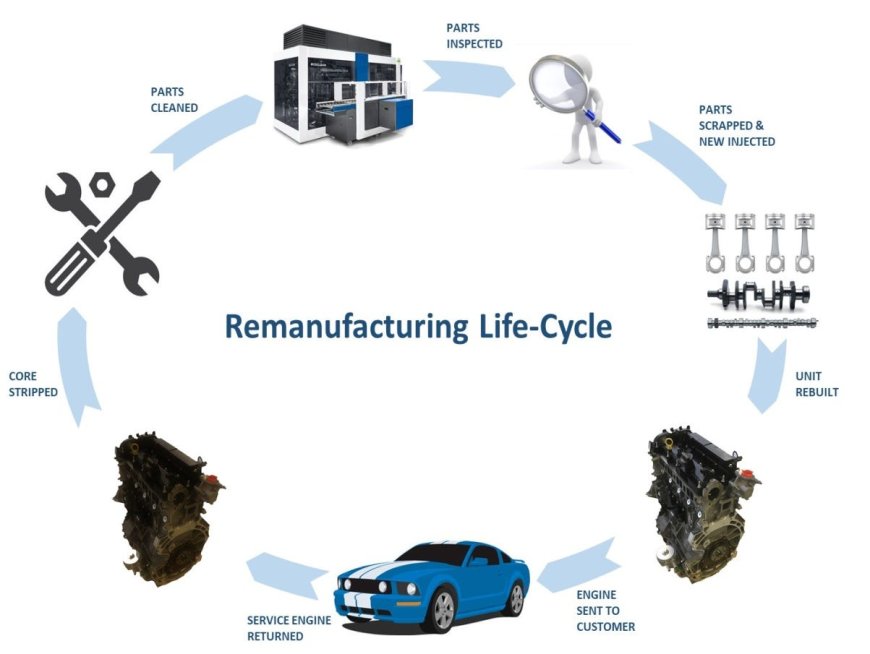Giving Parts a Second Life: Will Remanufacturing Drive a Sustainable Automotive Future?
The global automotive parts remanufacturing market is expected to reach nearly USD 190 billion in 2030, with a CAGR of around 7% during the forecast period 2023-2030.

The Infinium Global Research analyzes the Automotive Parts Remanufacturing Market over the period of 2023 to 2030. This report also provides detailed qualitative and quantitative analyses of the market dynamics, market size and future trends in global automotive parts remanufacturing market. It will help a lot of decision makers to develop strategies and find new opportunities in the global markets of automotive parts remanufacturing. The report covers market changing aspects including drivers, restraints, opportunities, and trends expected to encouragement the expansion of the automotive parts remanufacturing market during the period.
The global automotive parts remanufacturing market is expected to reach nearly USD 190 billion in 2030, with a CAGR of around 7% during the forecast period 2023-2030.
Get Sample pages of Report: https://www.infiniumglobalresearch.com/form/683?name=Sample
In the global automotive parts remanufacturing market, large players hold a significant share, dominating the market through their extensive networks, advanced technology, and strong brand recognition. Here's a detailed analysis based on the given content:
Market Shares and Revenue Opportunities
- North America: This region generates the highest revenue in the market, driven by a growing number of automotive manufacturers, support for remanufactured parts from OEMs and legislative authorities, and rapid technological advancements.
- Asia Pacific: Expected to grow with the fastest CAGR, attributed to the growing sale of vehicles and increasing demand for cost-efficient automotive parts.
Competition Level and Revenue Shares
- The market is highly competitive, with several key players such as Valeo, Budweg Caliper A/S, Carwood Group, MAVALgear, Meritor, Inc., ATC Drivetrain, Jasper Engines & Transmissions, Robert Bosch GmbH, ZF Friedrichshafen AG, and Genuine Parts Company.
- These companies hold a substantial revenue share due to their established presence and extensive product offerings.
Competitive Strategies
- Technological Integration: Companies are rapidly integrating advanced technology into vehicles, including hybrid and electric vehicles, to boost market growth.
- Support from OEMs: Increasing support from OEMs and legislative authorities is a key strategy to enhance market presence.
- Environment-Friendly Practices: Emphasizing recycling and promoting sustainable practices to align with the growing shift towards environment-friendly products and manufacturing in the automotive industry.
- Cost-Efficiency: Focusing on cost-efficient solutions to cater to the increasing demand for affordable automotive parts, especially in regions like Asia Pacific.
Does new product development really help companies?
Yes, new product development can significantly benefit companies. The remanufacturing industry's evolution over 70 years exemplifies this. Initially, defective units were scrapped, but the advent of remanufacturing allowed these parts to be renovated to meet specific technical standards, often with warranties comparable to new parts. This not only supports environmental sustainability by reducing the need for raw materials and encouraging recycling but also caters to a market demand for cost-efficient, high-quality parts. Technological advancements and shifting consumer preferences towards environmentally friendly products further bolster the growth of markets like automotive parts remanufacturing. Thus, new product development enables companies to adapt, meet market needs, and contribute to sustainability while potentially driving revenue growth and innovation.
To understand the trends in the automotive parts remanufacturing market, we need to consider various aspects including emerging trends, future trends, consumer trends, industry trends, and social trends. Let's break down each category with reference to the provided content.
Emerging Trends
- Technological Integration: The rapid integration of advanced technology into vehicles, including hybrid and electric vehicles, is an emerging trend that is expected to boost the automotive parts remanufacturing market.
- Environmental Focus: The growing shift towards environment-friendly products and manufacturing practices is another emerging trend driving the market. This includes the preference for remanufactured parts to reduce the environmental impact.
Future Trends
- Sustainable Practices: As the shortage of raw materials and fluctuations in their prices continue, the market will likely see an increased focus on recycling and sustainable practices, further boosting the demand for remanufactured parts.
- Regional Growth: The Asia Pacific region is expected to grow with the fastest CAGR, indicating a future trend of increased market share and activity in this region due to rising vehicle sales and demand for cost-efficient parts.
Consumer Trends
- Cost Efficiency: There is a growing demand for cost-efficient automotive parts, driving consumers towards remanufactured parts as a more affordable option compared to new parts.
- Environmental Awareness: Consumers are becoming more environmentally conscious, preferring products that contribute to sustainability. This is leading to increased acceptance of remanufactured automotive parts.
Industry Trends
- OEM Support: Increasing support for remanufactured parts from Original Equipment Manufacturers (OEMs) and legislative authorities is a significant industry trend. This support is facilitating the growth and acceptance of remanufactured parts in the market.
- Technological Advancements: Continuous technological advancements in the remanufacturing processes and the automotive industry are driving improvements in the quality and performance of remanufactured parts.
Social Trends
- Environmental Consciousness: The societal shift towards environmental consciousness and sustainability is influencing consumer choices and driving the demand for remanufactured parts, which are seen as an eco-friendlier option.
- Regulatory Impact: Social pressures and regulatory policies aimed at reducing environmental impact and promoting sustainability are likely to influence the remanufacturing industry. However, unfavorable regulatory policies can also pose challenges to market growth.
Keywords to Focus On
- Remanufacturing: The process of renovating used parts to meet specific technical specifications and offering the same warranty as new parts.
- Sustainability: Practices that promote environmental health, such as recycling and reducing the need for raw materials extraction.
- Cost-Efficiency: Providing affordable solutions without compromising quality, crucial for consumer adoption.
- Technological Integration: Incorporating advanced technologies into vehicles and remanufacturing processes to enhance performance and efficiency.
- OEM Support: Backing from Original Equipment Manufacturers, which is essential for market growth and consumer trust.
- Environmental Awareness: The growing consumer preference for products that contribute to a cleaner environment.
By focusing on these trends and keywords, businesses and stakeholders can better understand the dynamics of the automotive parts remanufacturing market and strategize accordingly.
Report Overview: https://www.infiniumglobalresearch.com/market-reports/global-automotive-parts-remanufacturing-market
Regional Analysis
North America Leads the Pack:
- Boasts the largest market share due to a high concentration of automakers and a well-established aftermarket.
- Rising support for remanufactured parts from original equipment manufacturers (OEMs) and government regulations are fueling further growth.
- Advancements in technology are also propelling the market forward in this region.
Asia Pacific: A Rising Star:
- Poised for the fastest growth rate due to a booming automotive industry with increasing vehicle sales.
- Cost-effectiveness is a major driver, as demand for affordable car parts surges in this region.
Europe and the Rest of the World:
- While not explicitly mentioned, these regions likely play a significant role in the global market as well.
- Further research would be needed to understand their specific growth drivers and market dynamics.
Conclusion
Large players in the automotive parts remanufacturing market hold a dominant share due to their strategic initiatives, technological advancements, and strong market presence. They capitalize on revenue opportunities through innovative and sustainable practices, ensuring they remain competitive in this rapidly evolving market.
What's Your Reaction?
 Like
0
Like
0
 Dislike
0
Dislike
0
 Love
0
Love
0
 Funny
0
Funny
0
 Angry
0
Angry
0
 Sad
0
Sad
0
 Wow
1
Wow
1




















































